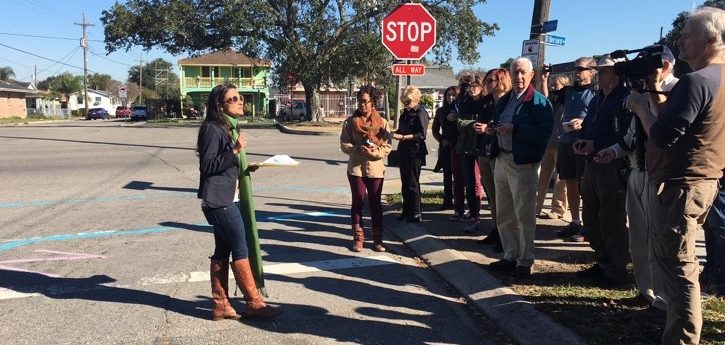Water—and sometimes, flooding—is a fact of life for residents and planners in the city of New Orleans. Water has shaped the city’s infrastructure, history and culture for 300 years.
In a four-hour field trip organized as part of AGU’s 2017 Fall Meeting, journalists, public information officers and others got a first-hand look at the water-related challenges New Orleans faces—and some of the innovative ways the city is taking those challenges on.
The trip was organized by ISeeChange, an AGU partner and the nation’s first community crowdsourced climate and weather journal. The organization works to empower community voices, data and perspectives in adaptation decisions in New Orleans. ISeeChange representatives led the tour along with local scientists and other experts.
“Our destinations follow the way water flows from New Orleans’ historic core to its outer boundaries, where we are experimenting with new ways to live with water, rather than treat it as an existential threat,” explains ISeeChange CEO and Founder Julia Kumari Drapkin. “Our goal was for participants to walk away from the tour with a new understanding of the geography, culture and resilience innovations that the city is pioneering.”
The tour centered around the Gentilly Resilience District, an initiative designed to reduce risk from flooding and subsidence and encourage neighborhood revitalization. Participants visited large-scale infrastructure projects such as drainage and pump stations, and heard neighborhood stories from the rainiest summer on record in New Orleans. They also visited spots where local residents are prototyping citizen science flood monitoring systems, saw demonstrations of new tools and solutions for planning smart cities and saw where the London Avenue Canal breached after Hurricane Katrina in 2005, with devastating results.
 “With recent flooding events, water has become an aspect of urban life that residents fear,” says Drapkin. “This tour focuses on how the city’s urban landscape is defined by water and how urban architects and the city are attempting to redefine that relationship, not only with infrastructure solutions, but also through our cultural approach to living with water.”
“With recent flooding events, water has become an aspect of urban life that residents fear,” says Drapkin. “This tour focuses on how the city’s urban landscape is defined by water and how urban architects and the city are attempting to redefine that relationship, not only with infrastructure solutions, but also through our cultural approach to living with water.”
Experts and speakers included green infrastructure architects from Waggoner and Ball, representatives from the city’s Sewerage and Water Board and the Office of Resilience, experts from the National Weather Service, scientists from the Tulane Bywater Institute, and local residents.
The field trip is just the latest outcome of an ongoing partnership between ISeeChange and AGU. Through Thriving Earth Exchange, the organizations have worked to pilot a flood monitoring project in the Gentilly Resilience District. Find the latest on that project here.

